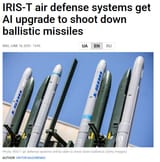Search Results
6/18/2025, 7:03:04 PM
>The IRIS-T air defense systems currently cannot intercept ballistic and hypersonic missiles. To expand the capabilities of the complexes, engineers plan to involve artificial intelligence, the Ukraine's analytical website Defense Express reports.
>According to the developers Diehl Defence and Hensoldt, IRIS-T SLM will receive new software and AI-based solutions.
>The integration of artificial intelligence is connected to the fact that "modern aerial attacks demonstrate significant complexity and diversity of means." Besides cruise missiles, supersonic and hypersonic missiles, and drones, ballistic missiles have "created new challenges for air defense."
>However, despite the possible impression that the Germans will "teach" IRIS-T to work against ballistic and even hypersonic targets, the discussion concerns other difficulties related to these threats - namely, automating the system's folding and deployment to constantly change its position.
>"We are working on fully automated processes and at least partially autonomous vehicles to be able to change positions as quickly as possible despite small crew numbers," Diehl Defence stated.
>The first steps toward this ultimate goal include involving artificial intelligence in target detection in the TRML-4D radar and integrating data from various sensors into a unified network.
>According to the developers Diehl Defence and Hensoldt, IRIS-T SLM will receive new software and AI-based solutions.
>The integration of artificial intelligence is connected to the fact that "modern aerial attacks demonstrate significant complexity and diversity of means." Besides cruise missiles, supersonic and hypersonic missiles, and drones, ballistic missiles have "created new challenges for air defense."
>However, despite the possible impression that the Germans will "teach" IRIS-T to work against ballistic and even hypersonic targets, the discussion concerns other difficulties related to these threats - namely, automating the system's folding and deployment to constantly change its position.
>"We are working on fully automated processes and at least partially autonomous vehicles to be able to change positions as quickly as possible despite small crew numbers," Diehl Defence stated.
>The first steps toward this ultimate goal include involving artificial intelligence in target detection in the TRML-4D radar and integrating data from various sensors into a unified network.
Page 1
